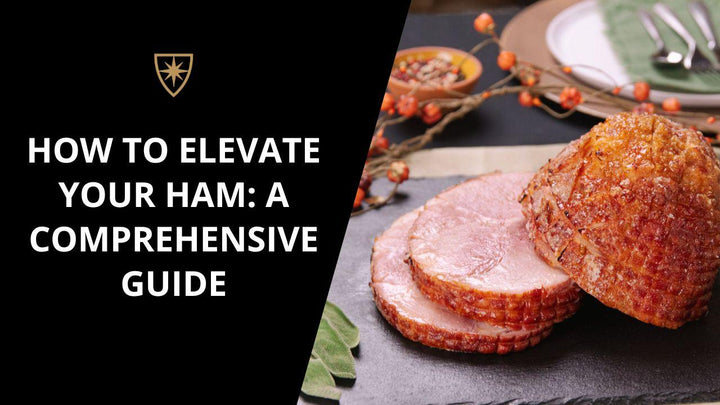How to Elevate Your Ham: A Comprehensive Guide

If you are in the "ham is just fine" club, it's time to think again. Hams come pre-cooked, smoked, or par cooked and store-bought ones usually come with a glaze packet. You add water to the glaze, heat up the ham, and call it a day. What if we told you it's easier than you think to make a ham one of the best meals you'll eat all year?
The first step is getting a good, quality ham. Our Kurobuta Ham is smoked, cured, and known to be some of the most succulent and flavorful ham around. Here's how you can make it even better across the five main portions of the process (don't worry, it's easy for novice cooks and experienced chefs alike).
STEAM. Add ¼ - ½ cup of water to the bottom of a roasting pan (adjust based on pan surface area, you want enough to cover the bottom). Keep the pan covered with foil - you want to create a bit of a steam effect and trap the moisture in for the majority of roasting, but remove the foil towards the end to crisp up the exterior.
GLAZE. You can mix up a variety of glazes but we highly recommend it includes each of these elements: sugar, acid, tanginess, fat, and savory. Pineapple offers the first three, so it’s used frequently with ham, but we like to add more layers of flavor by using different ingredients for each element. You can use a combination of citrus, brown sugar, bourbon, maple syrup, apple cider vinegar, etc. to achieve those three. For the savory element, we prefer dijon mustard and/or soy sauce in a smaller amount than the other elements, but those certainly aren’t the only options. The fat component is crucial to creating that crispy bark. Butter is the clear choice here, but we can see sinfully delicious possibilities with rendered wagyu fat or pork fat, which would double as a second layer of savory if you have any on hand. Mix your glaze on a low heat to thicken it up so it stays on the surface of the ham better throughout cooking.
PREP. Score the ham crosswise in inch wide sections, about 1 cm deep, to allow the glaze to penetrate the exterior of the ham. Take half your fat and pat into the scoring lines. Many recipes will recommend putting your ham on a rack elevated from the water in the pan, but we prefer putting the ham straight into the pan, cut side down, so it has a chance to soak up more flavor.
COOK. A pre-cooked/smoked ham should be reheated for around 20 minutes per pound at 325 degrees. Every 15-20 minutes, glaze the ham. An optional step is to add a sprinkle of sugar after each glaze to build up even more of a crust, but this is personal preference. On the final 20 minutes, remove the foil, add the remaining glaze, add a fat/sugar mixture around the exterior, and bump the heat to 375 to get a crispier bark.
FINISH. Let the ham rest on a cutting board for at least 10 minutes to ensure it retains as much juice as possible. Strain the liquid from the roasting pan into a sauce pan on med-low heat. Simmer for 10 minutes, stirring occasionally, until the sauce has thickened. Carve the ham and serve with the pan sauce. Trust us, do not skip the pan sauce, it’s where all the glaze flavor has concentrated and it takes already mouthwatering ham to the next level.









Hi Lynn,
The weights of our hams vary depending on which one you select and what we have in stock at the time. The Kurobuta hams are 4-6lbs, and our Mangalitsa hams come in various sizes!
What is the average weight on the hams ?
Leave a comment